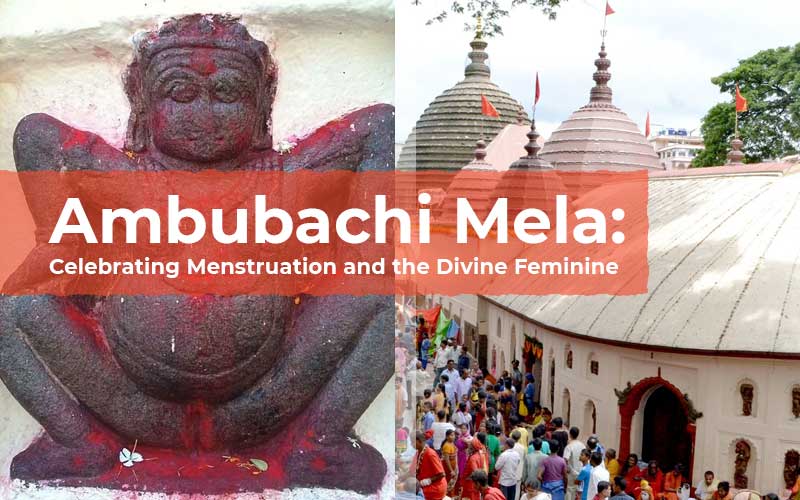
Ambubachi Mela: Celebrating Menstruation and the Divine Femininity
In the picturesque state of Assam, nestled atop the Nilachal Hill in Guwahati, lies a temple that stands as a beacon of empowerment and acceptance. The Kamakhya Temple is a sacred pilgrimage site where menstruation is not shrouded in silence or shame but considered a natural and powerful aspect of femininity. The temple celebrates a festival called "Ambubachi Mela" annually, which honors the goddess Kamakhya's menstruation cycle. During this time, the temple remains closed for three days as it is believed that the goddess is undergoing her menstrual cycle. This blog explores the belief system, societal taboos, the significance of the temple, and the vibrant celebration of Ambubachi that takes place within its sacred walls.
Belief System and Taboos:
In a country like- India, where menstruation is still a taboo, which separates women from taking part in many aspects of socio-cultural life. There are so many restrictions in their daily lives, where women are not allowed for offering prayers, to enter the kitchen or touch pickles during periods, touching holy books, to etc. People feel shy to talk openly about menstruation since it is regarded as a matter of disgrace. But the question that arises here is: why are we celebrating in Ambubachi Mela? The issue of the fact is that in Ambubachi Mela, people worship the Goddess who is mythologically presumed to have her periods.
According to the belief system surrounding the temple, the goddess undergoes her menstrual cycle during a specific time known as Ambubachi (month of Ashaad). Contrary to societal taboos that often surround menstruation; the Kamakhya Temple celebrates this natural process as a divine and sacred event.
Society's taboos around menstruation have historically led to the marginalization and stigmatization of women. However, in this temple, menstruation is seen as a source of power and a reminder of the divine energy that flows through women. By celebrating menstruation, the temple challenges age-old taboos and fosters a more inclusive and accepting society.
Significance of Kamakhya Temple
The Kamakhya Temple holds immense significance for devotees, both spiritually and culturally. It is one of the Shakti Peethas, the sacred sites associated with the goddess Shakti or Devi. It is believed that when the body of Sati was pierced into pieces by the 'Sudarshan Chakra' of Lord Bishnu, parts of the body fell into different places each creating a 'Shakti Peeth' which are thought to be very sacred. Similarly, the vagina (yoni - reproductive organ) of Sati fell in Pragjyotishpur or Assam, giving rise to the Kamakhya Temple. Thus, the temple represents the cosmic power of creation and the divine feminine energy.
Celebration of Ambubachi:
The Ambubachi Mela, the annual celebration at the Kamakhya Temple, commemorates the menstruation cycle of the goddess Kamakhya. This festival holds great significance and attracts thousands of devotees from far and wide. During the festival, the temple complex buzzes with a vibrant atmosphere. Devotees gather to seek blessings and participate in various rituals and ceremonies. It is believed that during these three days, the earth absorbs the divine energy emanating from the goddess. The festival is a celebration of femininity, fertility, and the power of creation, serving as a reminder of the inherent strength and importance of women in society.
The Ambubachi Mela is not only a religious event but also a cultural extravaganza. It offers a platform for artisans, craftsmen, and performers to showcase their talents. The streets surrounding the temple are adorned with colorful stalls selling traditional crafts, clothing, and local delicacies. Folk dances, music performances, and cultural programs further add to the festive spirit, creating an enchanting ambiance.
The Kamakhya Temple in Assam stands as a testament to the inclusive nature of Hinduism and challenges societal taboos surrounding menstruation. By celebrating menstruation as a divine process, the temple empowers women and fosters a more accepting society. The Ambubachi Mela serves as a vibrant celebration, blending spirituality, culture, and devotion. It is a reminder of the inherent strength and significance of women, encouraging us to embrace and celebrate all aspects of femininity in our lives.
As we continue to break down barriers and challenge deep-rooted taboos, the Kamakhya Temple stands as an inspiring example, showcasing the beauty and power that lies within every woman's natural cycles. Let us celebrate and support one another, fostering a society where menstruation is not met with shame or silence but with understanding, acceptance, and reverence for the divine feminine energy that flows through us all.
Disclaimer: The opinions expressed in this article are those of the author's. They do not purport to reflect the opinions or views of The Critical Script or its editor.

Newsletter!!!
Subscribe to our weekly Newsletter and stay tuned.

















Related Comments